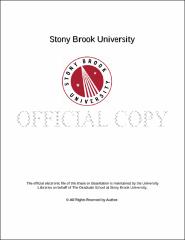| dcterms.abstract | The evolutionary mechanisms influencing biodiversity include abiotic and biotic factors, such as climate change, vicariance, ecological adaptation, and competition. I investigated evolutionary mechanisms that may have influenced the diversity of lemurs from Madagascar by testing geographic and ecological hypotheses in a phylogenetic framework. I used total-evidence methods to infer the lemur phylogeny and divergence times of extant and extinct species. I then tested macroevolutionary hypotheses about lemur biogeography based on the phylogeny to shed new light on the causes of lemur diversification. I examined macroevolution and biogeography at four geographic scales: island-wide, regions, localities, and multiple transects within localities. I inferred the evolutionary relationships and divergence times of nearly all extant and extinct lemurs (88% of species), as well as a broad sample of their living and extinct relatives. I used a total evidence approach, combining morphological and genetic data, to integrate the phylogenetic and temporal information captured with fossils (369 morphological characters, 5767 molecular characters from multiple independent loci). I found strong support for the phylogenetic relationships among lemurs, even for extinct species. Divergence time estimates for deep nodes were more recent and consistent with the fossil record than published molecular analyses of extant taxa, while divergences closer to the present were in line with previous studies. The divergence time estimate for the Haplorhine-Strepsirrhine split was ~ 60 million years ago (Ma), lemur origins were estimated ~40-50 Ma, and most of the family-level clades diverged after the Eocene-Oligocene boundary. These results have important implications for the diversification dynamics that led to disparities in diversity across the primate tree. The ecological theory of adaptive radiation predicts identifiable signatures in lineage and phenotypic diversification. I tested the hypothesis that lemurs diversified via an adaptive radiation by quantifying the speciation, extinction, and phenotypic evolutionary dynamics of lemurs and their closest living relatives, the lorisiform primates from Africa and Asia. I found that lemur speciation rates were low at their initial divergence and increased rapidly, with rates of increase slowing towards the present. Remarkably, speciation rates did not decrease towards the present, as would be expected if species richness were ecologically limited. In contrast, the speciation rates of lorisiforms were constant over time, but similar to lemur rates and no significant shift in rates was detected between lemurs and lorisiforms. Body mass evolution followed the predicted “early-burst†pattern of rapid trait divergence followed by a slow-down in trait evolution in lemurs, and phenotypic evolutionary rates differed significantly from the low and constant rates in lorisiforms. Lemurs exhibited the predicted adaptive ecological and phenotypic divergence associated with filling unique adaptive zones. The increase in lemur speciation rates towards the present suggests some processes influenced a continued rise in diversification, such as the late arrival of predators and non-lemur competitors, as well as biogeographic range shifts. Debate surrounds the relative importance of ecological adaptation compared to vicariant speciation to explain the extraordinary diversity and microendemism in Madagascar. I compared the roles of climate, habitat, geographic dispersal barriers, and interspecies competition in shaping lemur biogeography. I quantified the historical biogeographic patterns of dispersal and vicariance events to infer ancestral ranges and dispersal routes. I measured the taxonomic, phylogenetic, and functional composition of lemur communities from the local to island-wide scales. I found that some rivers were barriers to dispersal between northern and southern regions; however, temporal changes in dispersal probabilities in the Pleistocene did not explain this pattern. The geographic evolution of lemurs included frequent dispersal, especially to and from the central highlands, and high within-region diversification. Founder events and vicariance were less frequent. Biogeographic range shifts during the Oligocene and Miocene were apparent for many clades. The best predictor of phylogenetic community diversity at all scales was primary plant productivity, suggesting that communities with different habitat productivities have been separated longer than predicted by geographic barriers alone. Within local communities, co-occurring species were more distantly related than expected for a randomly assembled community and had high functional trait diversity, suggesting that niche partitioning shapes community composition. The results highlight the importance of including extinct subfossil lemur communities in biogeographic inferences because these phylogenetically and functionally diverse communities were found in the central highlands, where most lemur communities have gone extinct. While broad-scale differences in habitat and geographic barriers explain lemur community composition across the entire island, interspecific competition is predicted to influence local community assembly the most. I tested the hypothesis that competition is the dominant process shaping local community assembly. I compared the relative abundances of 13 lemur species on 31 transects along gradients of elevation and resource availability within southeast Madagascar. The functional diversity of communities was quantified based on trait dissimilarity to test for evidence of competition and environmental adaptation. The strongest predictor of lemur diversity was resource abundance. Where resources were most abundant, lemur communities were composed of closely related species that were ecologically dominant. Where resources were scarce, such as at high elevations, communities were composed of distantly related species. Functional diversity was highest where communities were clustered, suggesting character displacement, and lowest where communities were overdispersed, suggesting a few adaptive traits are shared by species. Resource abundance was an important factor shaping local community composition and influencing functional trait patterns. In summary, for the first time my dissertation research has approached lemur evolution and biogeography from phylogenetic and ecological perspectives to gain an overall picture of the mechanisms driving diversity. I found that the early ecological and phenotypic diversification of lemurs was coupled with increasing speciation rates. Speciation may have been driven by ecological adaptation and geographic range shifts, shaping lemur diversity in deep time. Local community assembly is related to resource abundance and the ability of some species to attain ecological dominance. The results suggest that environment, geography, and interspecies competition have operated at different scales to affect the evolution of lemur diversity. | |

